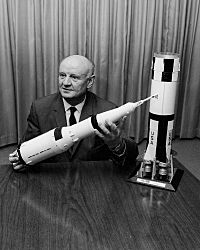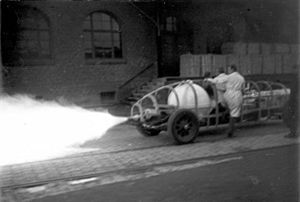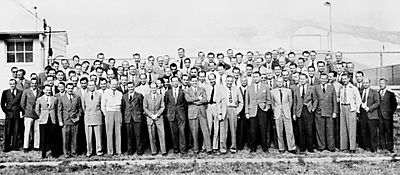Arthur Rudolph facts for kids
Quick facts for kids
Arthur Rudolph
|
|
|---|---|

Rudolph showing a model of the Saturn V
|
|
| Born |
Arthur Louis Hugo Rudolph
November 9, 1906 Stepfershausen, Meiningen, Saxe-Meiningen, German Empire
|
| Died | January 1, 1996 (aged 89) |
| Nationality | |
| Alma mater | Technical University of Berlin |
| Occupation | Rocket engineer |
| Known for | V-2, Saturn V |
| Spouse(s) | Martha Therese Kohls |
| Children | Marianne Erika Rudolph |
| Parent(s) | Gustav and Ida Rudolph |
| Awards |
|
Arthur Louis Hugo Rudolph (November 9, 1906 – January 1, 1996) was a German rocket engineer. He was a key leader in developing the V-2 rocket for Nazi Germany during World War II. After the war, the United States Government brought him to the U.S. through a secret program called Operation Paperclip.
In the U.S., he became a main developer of the American space program. He worked for the U.S. Army and NASA. He helped manage the creation of important systems, including the Pershing missile and the Saturn V Moon rocket. Later in his life, the U.S. Government investigated his past. He then agreed to give up his U.S. citizenship and leave the country.
Contents
Early Life and Education
Arthur Rudolph was born in Stepfershausen, Meiningen, Germany, in 1906. His family were farmers. His father, Gustav, died in 1915 while fighting in World War I. Arthur and his younger brother, Walter, were raised by their mother, Ida.
Ida noticed that young Arthur was good with machines. She decided he should get technical training. Walter stayed to manage the family farm. From 1921, Rudolph attended a technical school in Schmalkalden for three years. In 1924, he started working at a silver goods factory in Bremen.
Starting Work on Rockets
In August 1927, Rudolph got a job at Stock & Co. in Berlin. A few months later, he became a toolmaker at Fritz Werner. In 1928, he went to the Technical College of Berlin, now called the Technical University of Berlin. He graduated in 1930 with a degree in mechanical engineering.
On May 1, 1930, Rudolph began working for the Heylandt Works in Berlin. There, he met Max Valier, a pioneer in rocketry. Valier used the factory for his rocket experiments. Rudolph became interested and worked with Valier in his free time. He had already been interested in rockets, having read a book called Ways to Spaceflight and seen the film Woman in the Moon.
Sadly, on May 17, an experimental engine exploded, killing Valier. Dr. Paulus Heylandt, the factory owner, stopped further rocket research. But Rudolph secretly continued his work with two colleagues. Rudolph then created a better and safer version of Valier's engine. Dr. Heylandt eventually supported the project, and the "Heylandt Rocket Car" was shown at Tempelhof Aerodrome. It was a technical success, but it cost too much to run. Rudolph joined the Nazi Party in 1931.
Rudolph first met Wernher von Braun at a meeting of the "Spaceflight Society." In May 1932, Rudolph lost his job. He then met with a colleague who had talked to Walter Dornberger. Dornberger was in charge of developing rocket weapons for the German Ordnance Department.
After showing Dornberger their new engine, Rudolph moved to the testing grounds at Kummersdorf. He began working under von Braun. Rudolph's engine was used in the Aggregat series of rockets. In December 1934, the von Braun team successfully launched two A-2 rockets.
The Kummersdorf facilities were not big enough for continued work. So, the von Braun team moved to Peenemünde in May 1937. Rudolph was put in charge of building the A-3 test stand there. The Rudolphs lived in nearby Zinnowitz, where their daughter, Marianne Erika, was born. The A-3 rockets had problems with their guidance systems. In early 1938, Dornberger put Rudolph in charge of designing a new factory at Peenemünde. This factory would produce the A-4 series, which was later renamed the V-2 (meaning Reprisal Weapon-2).
World War II and Rocket Production
In August 1943, just as Rudolph was ready to start making the V-2, the British bombed Peenemünde. After the bombing, the V-2 production moved to the Mittelwerk facility. This facility was underground, near Nordhausen.
Mittelwerk was originally a gypsum mine. It was used for storage and then dug out to become a production factory. The workers were prisoners from a nearby camp. Rudolph was in charge of moving the equipment from Peenemünde to Mittelwerk. After the factory was set up, Rudolph became the operations director for V-2 missile production. Many workers faced very difficult conditions, and sadly, many lost their lives during the production of these rockets.
By March 1945, production had stopped because of a lack of parts. Rudolph and his team moved to Oberammergau. They later surrendered to the U.S. Army and were taken to Garmisch.
Moving to the United States
Rudolph was first transferred to the British for a short time. Then, he was transferred back to the Americans. The U.S. Army brought Rudolph's wife, Martha, and daughter, Marianne, from Germany. The Rudolph family was reunited. In November 1945, Rudolph, von Braun, and other German rocket scientists were brought to the U.S. for six months as part of "Operation Overcast." This operation was later renamed Operation Paperclip in March 1946. Most of the group stayed in the U.S. permanently.
After a brief interview, the team went to White Sands Missile Range in January 1946. There, they continued working on V-2 rocket engineering. In January 1947, Rudolph moved to Fort Bliss, El Paso, Texas. His family joined him there in April. Since he had come to the U.S. without a visa, he went to Juárez, Mexico. He got a visa there and officially moved to the U.S. on April 14, 1949.
On June 25, 1950, Rudolph was transferred to Redstone Arsenal, Huntsville, Alabama. He became an American citizen on November 11, 1954. In 1950, Rudolph was named the technical director for the Redstone missile project. In 1956, Rudolph was assigned as the project manager for the Pershing missile project. He chose The Martin Company as the main contractor for the program.
Rudolph received an honorary science degree from Rollins College in Florida in 1959. He also received the Department of the Army Decoration for Exceptional Civilian Service, the highest Army award for civilians, for his work on the Pershing missile.
Working at NASA
Even though von Braun and his team moved to NASA in 1960, Rudolph stayed with the Army to finish important work on the Pershing missile. In 1961, he finally moved to NASA, working again for von Braun. He became the assistant director of systems engineering. He helped connect the vehicle development at Marshall Space Flight Center with the Manned Spacecraft Center in Houston.
In August 1963, he became the project director of the Saturn V rocket program. He helped create the requirements for the rocket system and the mission plan for the Apollo program. The first Saturn V rocket launched perfectly on November 9, 1967, which was Rudolph's birthday.
He retired from NASA on January 1, 1969. During his time at NASA, he received the NASA Exceptional Service Medal and the NASA Distinguished Service Medal. On July 16, 1969, the Saturn V launched Apollo 11, which put the first humans on the Moon.
Later Life and Departure from the U.S.
In 1979, an investigator from the Office of Special Investigations (OSI) learned about Rudolph's past. The OSI looked into his connection with the use of forced labor at the Mittelwerk facility during World War II.
In September 1982, Rudolph was asked for an interview by the OSI. He thought it was just another routine interview, as he had been interviewed many times since coming to the U.S. The interviews focused on his early involvement with the Nazi Party and his possible role in the treatment of workers at Mittelwerk.
In November 1983, Rudolph signed an agreement with the OSI. He agreed to leave the United States and give up his U.S. citizenship. In return, he would not be prosecuted, and his family's citizenship and his retirement benefits would be safe. In March 1984, Arthur and Martha Rudolph left for West Germany. Rudolph then gave up his citizenship as agreed.
West Germany was concerned because Rudolph no longer had citizenship in any country. In July, West Germany asked the OSI for documents to decide if Rudolph should be prosecuted or given German citizenship. After reviewing the documents, German authorities investigated the case. In March 1987, the investigation concluded that there was no basis for prosecution under German law. Rudolph was then granted West German citizenship.
Meanwhile, there was a lot of discussion in the U.S. about Rudolph's case. Many people, including former military leaders and city officials, questioned the OSI's actions. Rudolph tried to get his U.S. citizenship back, but his case was dismissed in 1993.
Personal Life
Arthur Rudolph married Martha Therese Kohls on October 3, 1935, in Berlin. Soon after moving back to Germany, he had heart problems and underwent surgery. Arthur Rudolph died in Hamburg on January 1, 1996, from heart failure.
In Popular Culture
The character of Hans Udet in the novel Voyage by Stephen Baxter is based on Arthur Rudolph. Udet is described as a senior member of von Braun's V-2 team and the director of the Saturn V project. In the novel, Udet faces charges and leaves the U.S. to return to Germany.
Rudolph's name is also connected to some conspiracy theories, especially about UFOs and Area 51.
See Also
- List of German rocket scientists in the United States
- Operation Paperclip
- V-2 rocket
- Saturn V
Images for kids





